maintenance Citroen NEMO RHD 2015 1.G Owner's Manual
[x] Cancel search | Manufacturer: CITROEN, Model Year: 2015, Model line: NEMO RHD, Model: Citroen NEMO RHD 2015 1.GPages: 193, PDF Size: 8.3 MB
Page 2 of 193
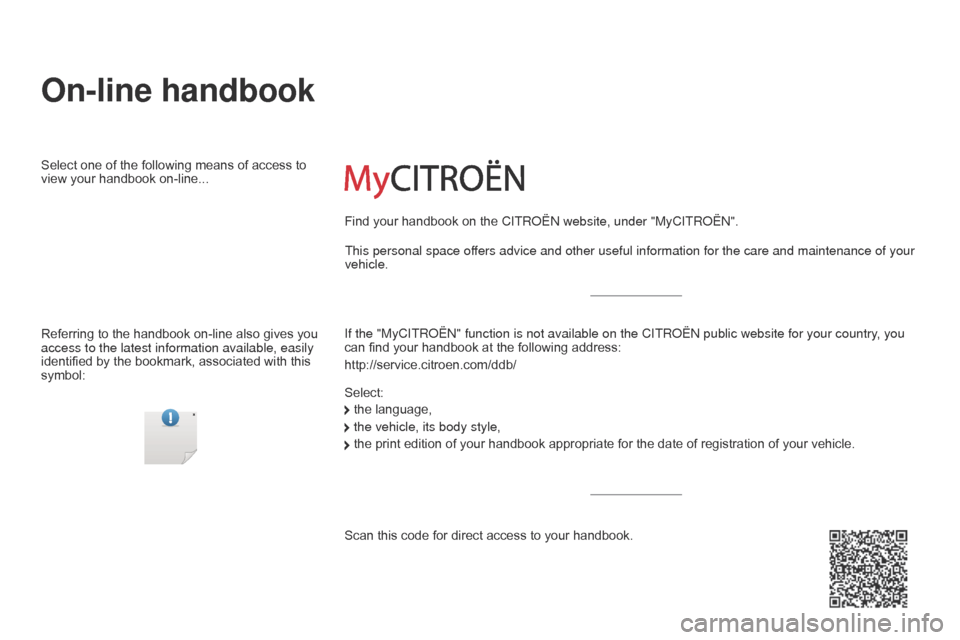
On-line handbook
This personal space offers advice and other useful information for the care and maintenance of\
your
vehicle.
If the "MyCITR
o Ë n " function is not available on the C ITR o Ë n public website for your country, you
can find your handbook at the following address:
http://service.citroen.com/ddb/
Select:
Select one of the following means of access to
view your handbook on-line...
Referring to the handbook on-line also gives you
access to the latest information available, easily
identified by the bookmark, associated with this
symbol:
the language,
the vehicle, its body style,
the print edition of your handbook appropriate for the date of registration of your vehicle.
Find your handbook on the
C ITR o Ë n website, under "MyCITR o Ë n ".
Scan this code for direct access to your handbook.
Page 4 of 193
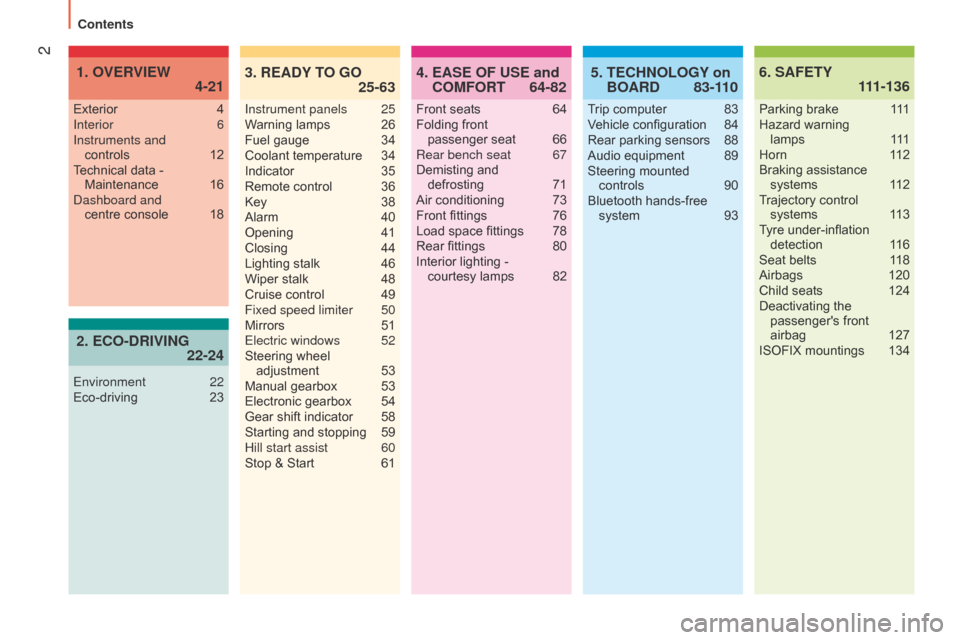
2
nemo_en_Chap00a_sommaire_ed02-2014
4. 64-82
EASE OF USE and
COMFORT 6.
111-136
SAFETY
Front seats 64
Folding front passenger
seat
66
Rear bench seat
67
Demisting and
defrosting
71
Air conditioning
73
Front fittings
76
Load space fittings
78
Rear fittings
80
Interior lighting - courtesy
lamps
82
Exterior
4
Interior
6
Instruments and controls
12
T
echnical data - Maintenance
16d
ashboard and centre
console
18
1. 4-21
OVERVIEW
Parking brake 1
11
Hazard warning
lamps
1
11
Horn
1
12
Braking assistance systems
1
12
Trajectory control systems
1
13
Tyre under-inflation detection
1
16
Seat belts
1
18
Airbags
120
Child seats
124
Deactivating the passenger's front
airbag
127
ISOFIX mountings
134
5. 83-1 10
TECHNOLOGY on
BOARD
Trip computer 83
V ehicle configuration 84
Rear parking sensors
88
Audio equipment
89
Steering mounted
controls
90
Bluetooth hands-free system
93
3. 25-63
READY TO GO
Instrument panels 25
W arning lamps 26
Fuel gauge
34
Coolant temperature
34
Indicator
35
Remote control
36
Key
38
Alarm
40
Opening
41
Closing
44
Lighting stalk
46
Wiper stalk
48
Cruise control
49
Fixed speed limiter
50
Mirrors
51
Electric windows
52
Steering wheel
adjustment
53
Manual gearbox
53
Electronic gearbox
54
Gear shift indicator
58
Starting and stopping
59
Hill start assist
60
Stop & Start
61
2. 22-24
ECO-DRIVING
Environment 22
Eco-driving 23
Contents
Page 18 of 193
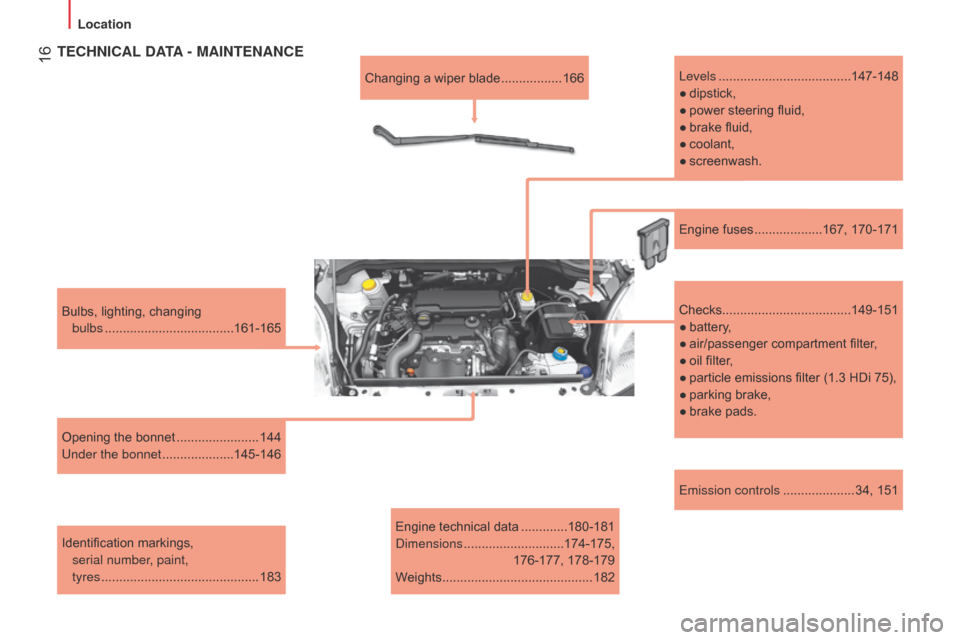
16
Emission controls ....................34, 151
Bulbs, lighting, changing
bulbs
.......
.............................
161-165
Opening the bonnet
....................... 144
Under the bonnet
....................
145-146
Identification markings,
serial number, paint,
tyres
............................................ 183Changing a wiper blade
.................
166
Engine technical data
.............180-181
d
imensions
............................ 174-175,
176-177, 178-179
Weights
.......................................... 182
TECHNICAL DATA - MAINTENANCE
Levels .....................................147-14 8
●
dipstick,
●
power steering fluid,
●
brake fluid,
●
coolant,
●
screenw
ash.
Checks.................................... 149-151
●
battery
,
●
air/passenger compartment filter
,
●
oil filter
,
●
particle emissions filter (1.3 HDi 75),
●
parking brake,
●
brake pads.
Engine fuses
...................167, 170-171
Location
Page 26 of 193
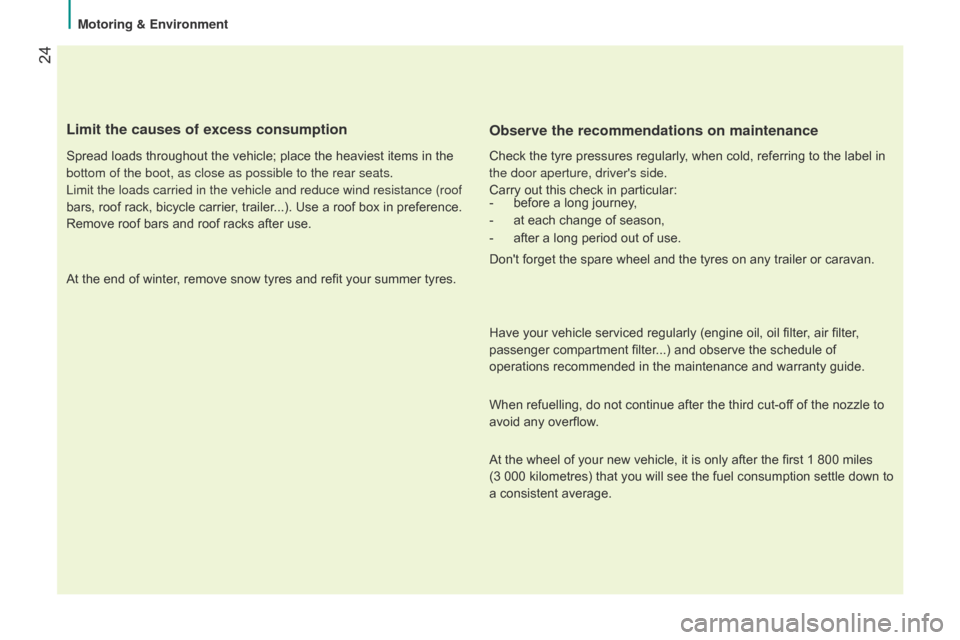
24
Limit the causes of excess consumption
Spread loads throughout the vehicle; place the heaviest items in the
bottom of the boot, as close as possible to the rear seats.
Limit the loads carried in the vehicle and reduce wind resistance (roof\
bars, roof rack, bicycle carrier, trailer...). Use a roof box in preference.
Remove roof bars and roof racks after use.
At the end of winter, remove snow tyres and refit your summer tyres.
Observe the recommendations on maintenance
Check the tyre pressures regularly, when cold, referring to the label in
the door aperture, driver's side.
Carry out this check in particular:
-
before a long journey
,
-
at each change of season,
-
after a long period out of use.
Don't forget the spare wheel and the tyres on any trailer or caravan.
Have your vehicle serviced regularly (engine oil, oil filter
, air filter,
passenger compartment filter...) and observe the schedule of
operations recommended in the maintenance and warranty guide.
When refuelling, do not continue after the third cut-off of the nozzle to
avoid any overflow.
At the wheel of your new vehicle, it is only after the first 1 800 miles
(3 000 kilometres) that you will see the fuel consumption settle down to
a consistent average.
Motoring & Environment
Page 37 of 193
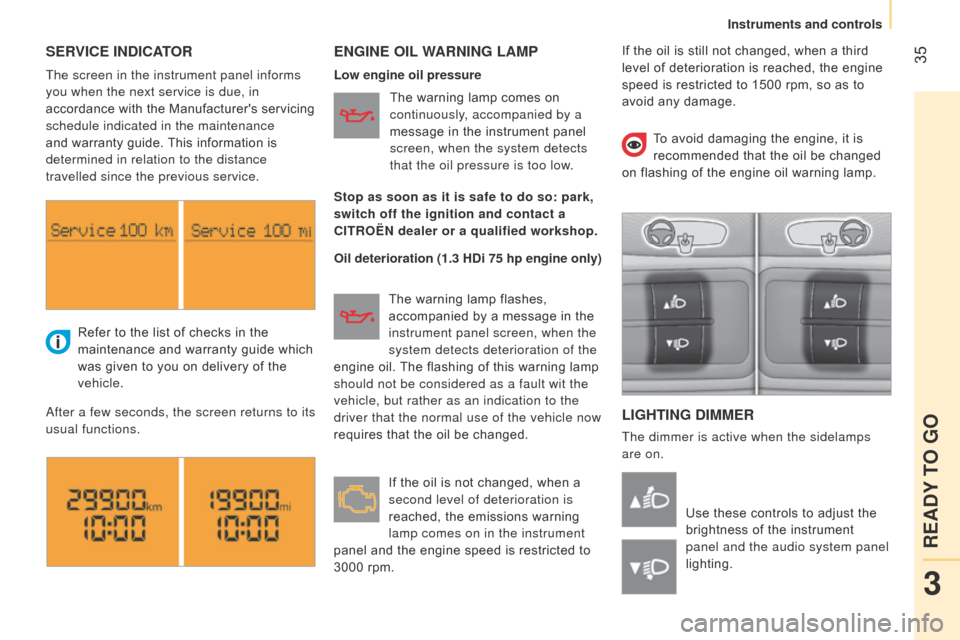
35SERVICE INDICATORENGINE OIL WARNING LAMP
L IGHTING DIMMER
The dimmer is active when the sidelamps
are on.
Refer to the list of checks in the
maintenance and warranty guide which
was given to you on delivery of the
vehicle.
a
fter a few seconds, the screen returns to its
usual functions.
Use these controls to adjust the
brightness of the instrument
panel and the audio system panel
lighting.
The screen in the instrument panel informs
you when the next service is due, in
accordance with the Manufacturer's servicing
schedule indicated in the maintenance
and warranty guide. This information is
determined in relation to the distance
travelled since the previous service.
Low engine oil pressure
Oil deterioration (1.3 HDi 75 hp engine only)The warning lamp comes on
continuously, accompanied by a
message in the instrument panel
screen, when the system detects
that the oil pressure is too low.
The warning lamp flashes,
accompanied by a message in the
instrument panel screen, when the
system detects deterioration of the
engine oil. The flashing of this warning lamp
should not be considered as a fault wit the
vehicle, but rather as an indication to the
driver that the normal use of the vehicle now
requires that the oil be changed.
If the oil is not changed, when a
second level of deterioration is
reached, the emissions warning
lamp comes on in the instrument
panel and the engine speed is restricted to
3000 rpm. To avoid damaging the engine, it is
recommended that the oil be changed
on flashing of the engine oil warning lamp.
Stop as soon as it is safe to do so: park,
switch off the ignition and contact a
CITROËN dealer or a qualified workshop. If the oil is still not changed, when a third
level of deterioration is reached, the engine
speed is restricted to 1500 rpm, so as to
avoid any damage.
3
READY TO GO
Instruments and controls
Page 65 of 193
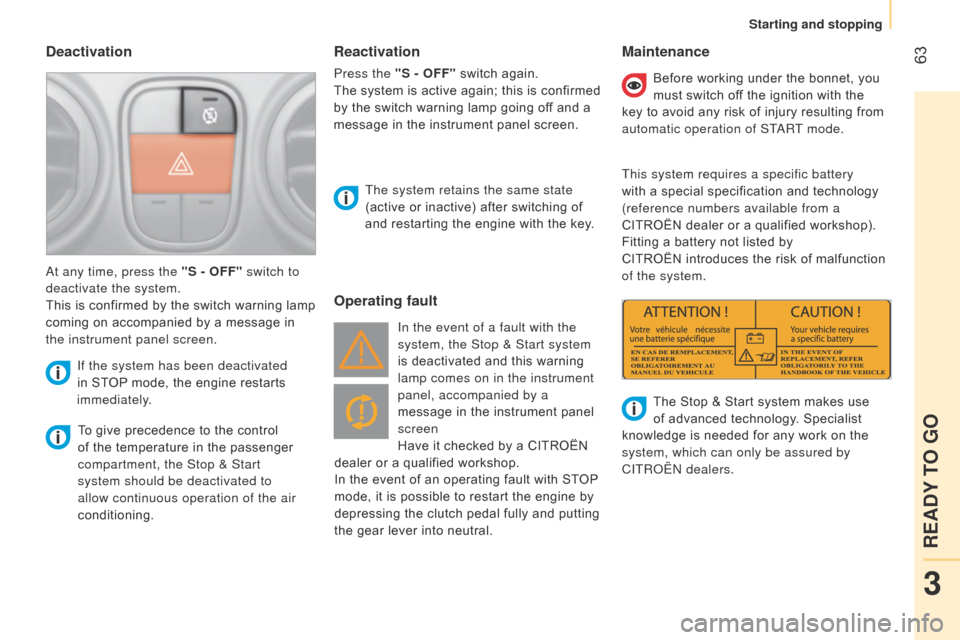
63Deactivation
To give precedence to the control
of the temperature in the passenger
compartment, the Stop & Start
system should be deactivated to
allow continuous operation of the air
conditioning.The system retains the same state
(active or inactive) after switching of
and restarting the engine with the key.
a
t any time, press the "S - OFF" switch to
deactivate the system.
This is confirmed by the switch warning lamp
coming on accompanied by a message in
the instrument panel screen.
If the system has been deactivated
in STOP mode, the engine restarts
immediately.
Operating fault Maintenance
In the event of a fault with the
system, the Stop & Start system
is deactivated and this warning
lamp comes on in the instrument
panel, accompanied by a
message in the instrument panel
screen
Have it checked by a CITROËN
dealer or a qualified workshop.
In the event of an operating fault with STOP
mode, it is possible to restart the engine by
depressing the clutch pedal fully and putting
the gear lever into neutral. Before working under the bonnet, you
must switch off the ignition with the
key to avoid any risk of injury resulting from
automatic operation of ST
a
RT mode.
This system requires a specific battery
with a special specification and technology
(reference numbers available from a
CITROËN dealer or a qualified workshop).
Fitting a battery not listed by
CITROËN introduces the risk of malfunction
of the system.
The Stop & Start system makes use
of advanced technology. Specialist
knowledge is needed for any work on the
system, which can only be assured by
CITR
o Ë n dealers.
Reactivation
Press the "S - OFF" switch again.
The system is active again; this is confirmed
by the switch warning lamp going off and a
message in the instrument panel screen.
3
READY TO GO
Starting and stopping
Page 142 of 193

140
Range of accessories for private vehicles
Another range is also available from
CITRo Ë n dealers.
"Comfort":
insulated module, coat hanger fixed to a
head restraint, reading lamp, rear parking
sensors...
"Transport solutions":
boot liner, rear door net, set of transverse
and longitudinal roof bars, roof boxes...
"Style":
embellishers, secure wheel embellishers... "Security and safety":
anti-intrusion alarm, window etching,
breathalyzer, first aid kit, high visibility vest,
warning triangle, child seats and booster
cushions, snow chains...
"Protection":
rubber mats, over-carpets, 3D mats, seat
covers compatible with lateral airbags, sets
of front and rear mudflaps...
"Multimedia":
audio systems, hands-free kit, speakers,
portable satellite navigation systems, speed
camera detectors, Wi-Fi on board...
By going to a CITROËN
dealer, you can also
obtain cleaning and maintenance products
(interior and exterior) - including ecological
products from the "TECHNATURE" range -
products for topping up (screenwash...),
touch-up pens and paint aerosols for the
exact colour of your vehicle, recharges
(cartridge for the temporary puncture
repair kit...), ...
To avoid any risk of jamming of the pedals:
-
ensure that the mat is positioned and
secured correctly,
-
never fit one mat on top of another
.
Equipment
Page 143 of 193

141TOTAL & CITROËN
Partners in performance and protecting the
environment
Innovation in the search for performance
For over 40 year, the TOTAL Research and
d
evelopment departments have developed for
CITR
o Ë n , lubricants to match the latest technical
innovations on CITR
o Ë n vehicles, both for
competition and for everyday motoring.
For you, this is an assurance that you will obtain
of the best performance for your engine.
Optimum protection for your
engine
By having your CITROËN vehicle
serviced with T
o
T
a
L lubricants, you
are contributing towards improving
the life and performances of your
engine, while also protecting the
environment.
prefers
8
CHECKS
Maintenance with TOTAL
Page 145 of 193

143
Resetting
To set off again, restore the fuel supply and
the electrical supply manually:
-
with the key in the
STOP position, turn
the key to the RUNNING position,
-
push the direction indicator control stalk
fully upwards,
-
place it in the "Of
f" position,
-
press the direction indicator control stalk
fully downwards,
-
return it to the "Of
f" position,
-
push it fully upwards again,
-
return it to the "Of
f" position,
-
press it fully downwards again,
-
return it to the "Of
f" position,
-
turn the key to the
STOP position.
Fuel used for petrol engines
The petrol engines are compatible with
E10 bio-petrol (containing 10 % ethanol),
conforming to European standards EN 228
and EN 15376.
E85 type fuels (containing up to 85 %
ethanol) are reserved exclusively for
vehicles marketed for the use of this type
of fuel (b ioFlex vehicles). The quality of
the ethanol must comply with European
standard EN 15293.
Fuel used for Diesel engines
The Diesel engines are perfectly with
biofuels which conform to current and future
European standards (
d iesel fuel which
complies with standard EN 590 mixed
with a biofuel which complies with standard
EN 14214) available at the pumps
(containing up to 7 % Fatty Acid Methyl
Ester).
The B30 biofuel can be used in certain
Diesel engines; however, this use is subject
to strict application of the special servicing
conditions indicated in the maintenance and
warranty guide. Contact a CITROËN dealer
or a qualified workshop.
The use of any other type of (bio)fuel
(vegetable or animal oils, pure or diluted,
domestic fuel...) is strictly prohibited (risk of
damage to the engine and fuel system).
8
CHECKS
Fuel
Page 149 of 193
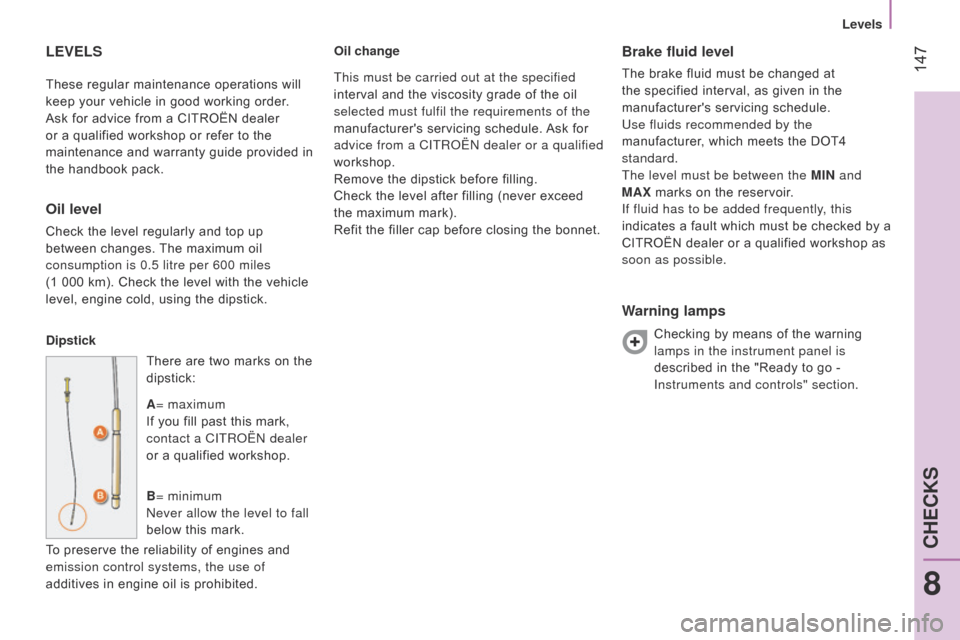
147These regular maintenance operations will
keep your vehicle in good working order.
Ask for advice from a CITROËN dealer
or a qualified workshop or refer to the
maintenance and warranty guide provided in
the handbook pack.
LEVELS
Oil level
Check the level regularly and top up
between changes. The maximum oil
consumption is 0.5 litre per 600 miles
(1 000
km). Check the level with the vehicle
level, engine cold, using the dipstick.
Dipstick There are two marks on the
dipstick:
A= maximum
If you fill past this mark,
contact a CITR
o Ë n dealer
or a qualified workshop.
B = minimum
n
ever allow the level to fall
below this mark.
To preserve the reliability of engines and
emission control systems, the use of
additives in engine oil is prohibited. Oil change
Brake fluid level
The brake fluid must be changed at
the specified interval, as given in the
manufacturer's servicing schedule.
Use fluids recommended by the
manufacturer, which meets the DOT4
standard.
The level must be between the MIN and
MAX marks on the reservoir.
If fluid has to be added frequently, this
indicates a fault which must be checked by a
CITROËN dealer or a qualified workshop as
soon as possible.
Warning lamps
Checking by means of the warning
lamps in the instrument panel is
described in the "Ready to go -
Instruments and controls" section.
This must be carried out at the specified
interval and the viscosity grade of the oil
selected must fulfil the requirements of the
manufacturer's servicing schedule. Ask for
advice from a CITR
o
Ë
n
dealer or a qualified
workshop.
Remove the dipstick before filling.
Check the level after filling (never exceed
the maximum mark).
Refit the filler cap before closing the bonnet.
8
CHECKS
Levels